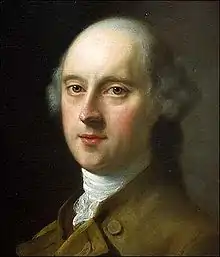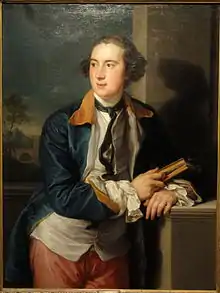William Legge, 2nd Earl of Dartmouth
William Legge, 2nd Earl of Dartmouth, PC, FRS (20 June 1731 – 15 July 1801), styled as Viscount Lewisham from 1732 to 1750, was a British statesman who is most remembered for his part in the government before and during the American Revolution, and as the namesake of Dartmouth College.
The Earl of Dartmouth | |
|---|---|
 The Earl of Dartmouth, by Nathaniel Hone | |
| First Lord of Trade | |
| In office 20 July 1765 – 16 August 1766 | |
| Monarch | George III |
| Prime Minister | The Marquess of Rockingham |
| Preceded by | The Earl of Hillsborough |
| Succeeded by | The Earl of Hillsborough |
| Secretary of State for the Colonies and First Lord of Trade | |
| In office 27 August 1772 – 10 November 1775 | |
| Monarch | George III |
| Prime Minister | Lord North |
| Preceded by | The Earl of Hillsborough |
| Succeeded by | Lord George Germain |
| Personal details | |
| Born | 20 June 1731 |
| Died | 15 July 1801 (aged 70) |
| Nationality | British |
| Spouse(s) | Frances Nicoll (d. 1805) |
Background
Dartmouth was the son of George Legge, Viscount Lewisham, who died when Dartmouth was one year old. His mother was Elizabeth, daughter of Sir Arthur Kaye, 3rd Baronet.[1] Having entered Trinity College, Oxford, in 1748,[2] he succeeded his grandfather in the earldom in 1750.

Political career
Lord Dartmouth was Secretary of State for the Colonies from 1772 to 1775. Lord Dartmouth's arrival in the Colonies was celebrated by Phillis Wheatley's famous poem, "To the Right Honourable William, Earl of Dartmouth."
It was Lord Dartmouth who, in 1764, at the suggestion of Thomas Haweis, recommended John Newton, the former slave trader and author of "Amazing Grace", to Edmund Keene, the Bishop of Chester. He was instrumental in Newton's acceptance for the Anglican ministry.
In 1772, in correspondence with Sir William Johnson, the Superintendent of Northern Indian Affairs in America, he suggested that there was no reasonable way the British Government could support new trade regulations with the Indians. He sympathised with Johnson's arguments but stated the Colonies did not seem inclined to concur with any new regulations.
Philanthropy
Lord Dartmouth was a large donor to and the leading trustee for the English trust that would finance the establishment of the Moor's Charity School, in Lebanon, Connecticut by Eleazar Wheelock to educate and convert the Indians. Wheelock subsequently founded Dartmouth College in Hanover, New Hampshire, naming the school in Lord Dartmouth's honour, in hopes of getting his financial support. Lord Dartmouth refused. In London, Lord Dartmouth supported the new Foundling Hospital, a charitable institution for the care and maintenance of London's abandoned children. He served as a vice-president of the organisation from 1755 until his death. The famous painter Sir Joshua Reynolds painted the Earl's portrait and donated it to the hospital. The portrait is still in the Foundling Hospital Collection and can be seen at the Foundling Museum in London. He was admitted a Fellow of the Royal Society on 7 November 1754.[3]
Marriage and children
Lord Dartmouth married Frances Catherine Nicholl, daughter of Sir Charles Gounter Nicoll, on 11 January 1755. They had six children together:
- George Legge, 3rd Earl of Dartmouth (born 3 October 1755, died 10 November 1810)
- Admiral the Hon Sir Arthur Kaye Legge KCB (born 1756, died 21 May 1835)
- Rt Rev and Hon Edward Legge (born 1756, died 27 January 1827), Bishop of Oxford 1816–27.
- Hon Henry Legge (born 23 January 1765, died 19 April 1844)
- The Ven and Hon Augustus George Legge (born 21 August 1773, died 1828), Archdeacon of Winchester 1814–19.
- Lady Charlotte Legge (born 5 October 1774, died 5 November 1848), married Charles Duncombe, 1st Baron Feversham
Dartmouth died at Blackheath, Kent, on 15 July 1801, in the seventy-first year of his age, and was buried in Trinity Church in the Minories on 3 August 1801.[4] He was succeeded by his eldest son, George. Lady Dartmouth died in July 1805. The family lived at Sandwell Hall (since demolished) in Sandwell Valley.
References
- Sykes, Daniel Frederick Edward "The History of Huddersfield and Its Vicinity" pg. 131
- Hopkins, Clare (2005), Trinity: 450 years of an Oxford college community (2007 reprint ed.), Oxford, ISBN 978-0-19-951896-8
- "Lists of Royal Society Fellows". Archived from the original on 10 December 2004. Retrieved 15 December 2006.
- Barker 1892.
- Attribution
![]() This article incorporates text from a publication now in the public domain: Barker, George Fisher Russell (1892). "Legge, William (1731-1801)". In Lee, Sidney (ed.). Dictionary of National Biography. 32. London: Smith, Elder & Co.
This article incorporates text from a publication now in the public domain: Barker, George Fisher Russell (1892). "Legge, William (1731-1801)". In Lee, Sidney (ed.). Dictionary of National Biography. 32. London: Smith, Elder & Co.
External links
| Political offices | ||
|---|---|---|
| Preceded by The Earl of Hillsborough |
First Lord of Trade 1765–1766 |
Succeeded by The Earl of Hillsborough |
| Preceded by The Earl of Hillsborough |
Colonial Secretary 1772–1775 |
Succeeded by Lord George Germain |
| First Lord of Trade 1772–1775 | ||
| Preceded by The Duke of Grafton |
Lord Privy Seal 1775–1782 |
Succeeded by The Duke of Grafton |
| Preceded by The Duke of Rutland |
Lord Steward 1783 |
Succeeded by The Duke of Chandos |
| Peerage of Great Britain | ||
| Preceded by William Legge |
Earl of Dartmouth 1750–1801 |
Succeeded by George Legge |
| Baron Dartmouth (descended by acceleration) 1750–1801 | ||
